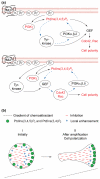Leukocytes navigate by compass: roles of PI3Kgamma and its lipid products
- PMID: 11050418
- PMCID: PMC2819116
- DOI: 10.1016/s0962-8924(00)01841-9
Leukocytes navigate by compass: roles of PI3Kgamma and its lipid products
Abstract
Morphologic polarity is necessary for the motility of mammalian cells. In leukocytes responding to a chemoattractant, this polarity is regulated by activities of small Rho guanosine triphosphatases (Rho GTPases) and the phosphoinositide 3-kinases (PI3Ks). Moreover, in neutrophils, lipid products of PI3Ks appear to regulate activation of Rho GTPases, are required for cell motility and accumulate asymmetrically to the plasma membrane at the leading edge of polarized cells. By spatially regulating Rho GTPases and organizing the leading edge of the cell, PI3Ks and their lipid products could play pivotal roles not only in establishing leukocyte polarity but also as compass molecules that tell the cell where to crawl.
Figures






References
-
- Wymann MP, Pirola L. Structure and function of phosphoinositide 3-kinases. Biochim. Biophys. Acta. 1998;1436:127–150. - PubMed
-
- Sasaki T, et al. Function of PI3Kγ in thymocyte development, T cell activation, and neutrophil migration. Science. 2000;287:1040–1046. - PubMed
-
- Li Z, et al. Roles of PLC-β2 and -β3 and PI3Kγ in chemoattractant-mediated signal transduction. Science. 2000;287:1046–1049. - PubMed
-
- Hirsch E, et al. Central role for G protein-coupled phosphoinositide 3-kinase γ in inflammation. Science. 2000;287:1049–1053. - PubMed
-
- Maier U, et al. Roles of non-catalytic subunits in Gβγ-induced activation of class I phosphoinositide 3-kinase isoforms β and γ. J. Biol. Chem. 1999;274:29311–29317. - PubMed
Publication types
MeSH terms
Substances
Grants and funding
LinkOut - more resources
Full Text Sources
Other Literature Sources

